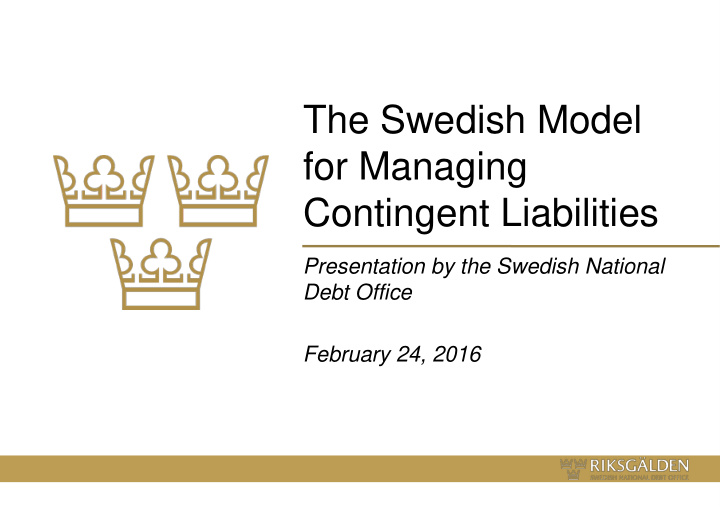



The Swedish Model for Managing Contingent Liabilities Presentation by the Swedish National Debt Office February 24, 2016
Agenda o The Swedish model for government guarantees and loans Background Institutional set-up Guiding rules and principles • Characteristics of the portfolio • Methods for measuring and managing credit risk • Key lessons learned
The Swedish Model For Guarantees and Loans • Central government guarantees first regulated in Budget Act of 1996. • Budget Act revision in 2011. On-lending regulated in the same way as credit guarantees. • Guiding principles Transparency Cost coverage Risk management ”The proof of the pudding is in the eating ”
Swedish Regulatory and Institutional Framework • Guarantees and loans approved by Parliament and commissioned by the government. • Parliament decides on amount, purpose and instrument. • Annual limit approved for programs, eg. student loans and export credit guarantees. • A fee must cover at least total expected cost (expected loss and administration). • An amount corresponding to expected loss is transferred to notional reserve account. • Losses on guarantees and loans covered by reserves. Any shortfall is financed via an unlimited credit facility. • When EU state aid rules apply a market based fee must be charged. • Fee exceeding expected loss (market risk premium related to unexpected losses, liquidity premium etc.) is transferred back to the central government budget.
Student loans (36,4%) Composition of Portfolio Export credit guarantees (31,4%) Guarantees to Multilateral Development Banks (22%) Infrastructure loans and guarantees (4,6%) Pension guarantees (1,5%) Credit guarantees - international undertakings (1,2%) Loans to sovereigns (1,0%) Development aid (0,5%) Housing credit (0,4%) Other Share of GDP (ex deposit guarantee) = 14 %
Ensuring Adequate Credit Risk Profile • To estimate a correct fee the credit risk must be identifiable , manageable and measurable. • Ensure that the beneficiary is not in financial distress. • Guarantees should have finite amount and maturity. • Risk sharing aligns the incentives of the lender and the guarantor. • Risk mitigation via legal covenants • Collateral may be used to reduce the credit risk, especially if the credit profile of the beneficiary is weak.
Overview of Credit Risk Assessment and Pricing • The Guarantee and Loan department at the SNDO is responsible for managing a portfolio of non-standardized guarantees and on-lending. • Mainly corporate credit risk (single beneficiary), but some guarantees where the credit risk is on a portfolio of beneficiaries, requiring a more structured finance type approach. • The SNDO strives for best practice in methods used. • A rating based approach is preferred method for credit risk assessment. • When a ratings based approach is not appropriate then simulation models, such as Monte-Carlo, are used for calculating expected loss
Credit Rating Analysis by the SNDO • A rating is a relative measure of credit risk, comparable across industries and regions. • A rating analysis involves determining an issuer rating and as an issue specific rating . • The issuer rating measures probability of default of the beneficiary, factoring in willingness and ability to meet obligations. • The issuer rating takes into account business risk, financial risk, and potential external support, as well as any effect that the country ceiling may have on the rating. • In order to arrive at the issue rating for the specific transaction, the expected loss given default must be factored. The priority of claim is analyzed, notching up for security or down for subordination. • For a senior unsecured transaction, the issue rating is the same as the issuer rating, factoring average recovery prospects.
Example of Rating Grid Factors Source: Moody’s Rating Methodology - Government Owned Toll Roads, October 3, 2012.
Pricing of Guarantees and Loans (continued) • Expected loss Rating - Default and recovery databases from credit rating agencies. Simulation model – expected loss calculated output of the model • Market price CDS quotes or bond yields for same credit rating (ensuring comparable characteristics). If a bond yield is used, then a reference rate must be chosen and deducted from the bond yield to arrive at a credit spread.
Key Lessons Learned • Guarantees and on-lending give rise to the same credit risk • Documentation is part of risk assessment and risk management • Pay attention to priority of claim
Recommend
More recommend